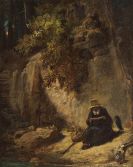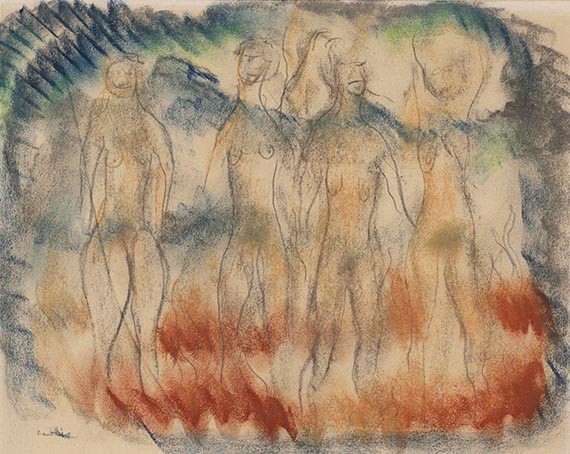
Romanticism
In the visual arts, Romanticism is the epoch between 1790 and 1830; it developed near the time of Classicism and overlaps with it. Romanticism is, to be sure, not a homogenous style either in terms of content or of the national characteristics of its time, but rather a world view that has much to do with the critical time period between revolution and restoration. Nevertheless, common characteristics include the emphasis on the poetic and the emotional as well as a fondness for the national past. In this connection, a first interest in the stylistic elements of the Middle Ages appears, which then in historicism comes into full flower. The mystical immersion in nature also becomes a motif of romanticism: by way of the philosophical trend of pantheism, nature is understood as an incarnation of God, in which human beings can find their way back to their origins. On the basis of these backgrounds, the term "Romanticism" can be traced etymologically to the adjective "romantic", like a novel, and at first it had negative connotations because novels often contained fantastic or adventurous subject matter.
In contrast to academic and national classicism, romanticism – disappointed by the events of the revolution – turns to a bourgeois intimacy; the Enlightenment’s rationalism is criticized, and Jean Jacques Rousseau proclaimed that the artist should express his personal feelings vividly. The observer was to experience these pictorial statements directly through the senses and to be able to translate them subjectively; an intellectual decoding of the themes is not urgently necessary. The ideals of romanticism manifest themselves most clearly in painting. In England, landscape pictures dominated: natural phenomena were observed, to be sure, but their pictorial translation is done by means of a choppy brush style and pasty paint application. In romanticism in general, color is valued over the linear style of classicism; in William Turner’s work, this is clearly the case increasingly with respect to the form.
In Germany, the landscape also has an important task; in the paintings of Caspar David Friedrich, human beings appear only as background figures and thus offer the observer an opportunity for identification. The paint application is, unlike in England, glazing, and the paint strokes are hardly visible; in addition, in contrast with the general ideas in Friedrich, a complicated symbolism can be found. On the other hand is the situation in France. Landscape idylls are not chosen as pictorial content, but rather subjects with tragic content are preferred. Representation of dramatic, epic themes or catastrophes is favored. In terms of style, the colors in France are also more autonomous. The lighting does not serve the delineation of form, but rather supports the dramatization of the events in the picture; in this sense, the composition is also more animated.
Romantic artists include: John Constable, Eugène Delacroix, Caspar David Friedrich, Johann Heinrich Füssli, Theodore Géricault, Philipp Otto Runge, William Turner.

Would you like to sell a work of Romanticism?
Infos for sellerART MARKET:

Lesender Einsiedler mit Raben in einer Schlucht
Oil on cardboard, on canvas, 1830
Estimated price 60.000
More offers >






